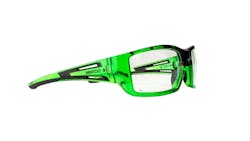With all the safety glasses on the market today, it may seem difficult to choose one you can say is “just right” for you. When comparing, I look for comfort, low visibility distortion, and of course, how safe the glasses actually are. With the Matco Tools ForceFlex Safety Glasses, I found all of those requirements are met, and are met with flying colors.
For their production, Matco Tools contracted with a company called Radians to build ForceFlex Safety Glasses. Radians has become a major leader in the safety industry by manufacturing high-performance personal protective equipment (PPE) for the industrial, construction, and safety markets. ForceFlex Safety Glasses feature eight accepted patents and have four patents pending.
Some of the features that Matco has published are “key flex points … with an elastomeric compound which provide incredible flexibility while retaining the original form” and “i-Form flexible frames [that] perfectly fit any size head, eliminating pressure points and providing maximum comfort." I found these are why the glasses are so comfortable. The level of comfort is important if you wear safety glasses for extended periods of time and do so daily. If you wear safety glasses that aren’t comfortable then you're likely to not wear them as much as you should.
The lenses have no distortion, and, as Matco advertises, the “polycarbonate substructure provides maximum durability." To me, durability equates to fewer scratches and longer life. They’re also advertised as having “T-axis optics [to] provide unparalleled optics engineered for zero distortion across the entire lens." I noticed mine did not fog up despite the high humidity in which they were used. Again, an important feature for safety glasses.
"ForceFlex frames exceed the highest ballistic standards ANSI Z87.1 - CSA Z94.3-2014 - EN 166 - ASTM F803 - MIL-PRF-31020," Matco states. That means these glasses meet a U.S. civilian ballistic eyewear standard (ANSI Z87.1), a Canadian ballistic standard (CSA Z94.3), and a European standard (EN 166), but not any U.S. military standards (APEL requirements). Of note, I was unable to locate any specific description for "MIL-PRF-31020" that was also advertised.
Pro(s): 22 styles available: Full-frame, half-frame, or frameless versions offered with various lens shapes and colors enough to suit almost any safety glasses wearer. Intrablock UV protection lens infusion technology provides 100 percent UVA, UVB, and UVC protection.
Con(s): They do not fit over prescription eyeglasses. These are not adjustable.
About the Author

Jaime Lazarus
Jaime Lazarus retired in 2020 after 41 years in the transportation repair sector. Throughout his career, he filled such positions as “lube tech", mechanic, technician, shop-owner, inventor, automotive technologies instructor, and published author. Also known as “The Car Whisperer”, he was widely diversified in automotive diagnostics. Lazarus focused his career on emerging automotive technology, recognizing early on that the biggest challenge for automotive repair technicians is diagnosing electrical systems and electronic components. He was a four-time certified ASE Master Automotive Technician that had held the L-1 (Advanced Engine Performance) certification since the test's inception.
